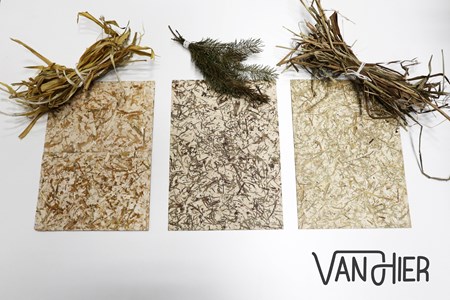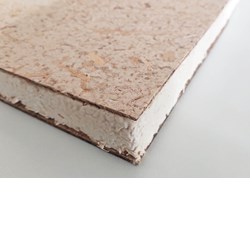Horticultural waste and natural residual streams are now mainly burned or composted, which is an enormous value destruction.
These residual flows can also be examined to be of value in other ways. By drying and grinding these waste streams, new useful raw materials are created from which new materials and products can be made. This way you can add value to horticultural waste instead of destroying it.
VanHier developed a recipe and production process to convert natural residual flows into sheet material. The possibilities are endless, for example we can process agricultural, horticultural and natural waste into sheet material. This material can be used as a finishing in interior design, or for furniture and product designers. We call this material FytoPanel.
FytoPanel consists of 100% natural fibres and natural binders. It is a high-quality decorative laminate with a beautiful natural look. The thinnest sheet of FytoPanel has a thickness of approximately 2 mm and is thermoformable and bendable. It is moisture-removable and suitable for indoor applications. The thicker Fytopanels can be used both constructively and decoratively.
To obtain strength properties, you can apply FytoPanel as a veneer to sheet material, or laminate multiple sheets with a natural binder.
The fibers of the horticultural waste are clearly visible in the sheets, giving them a beautiful natural look. Each waste stream has different properties and a different look.
We can offer different colors of sheets by processing natural non-damaging color pigments. We work with semi-transparent colors so that the decorative effect of the natural fibers remains visible.
Unlike plastic sheet material, FytoPanel is biodegradable (compostable), also recyclable, not harmful to nature and climate positive.
VanHier is certified 'Future-proof Construction'.


BioM consists of 100% natural fibers and natural binders. It is a high-quality decorative laminate with a beautiful natural appearance. We process different types of natural residual streams into thin formable sheet material. We produce sheets with residual materials Freesia, Cattail, Reed, Roses/Flowers and Fir. The character of the natural fibers can be seen in the plates. We can also add natural pigments to the veneer to offer a different color palette.
Van Hier develops new materials from various types of natural fibers left over from horticulture. These include residual flows of, for example, freesia leaves from a flower grower or reed cuttings from Natuurmonumenten. For these residual flows, we develop various recipes corresponding to the different types of natural fibers. We test the recipes and process them in our production process to produce thin, mouldable sheet material. In addition to use as veneer, we are also developing other products.